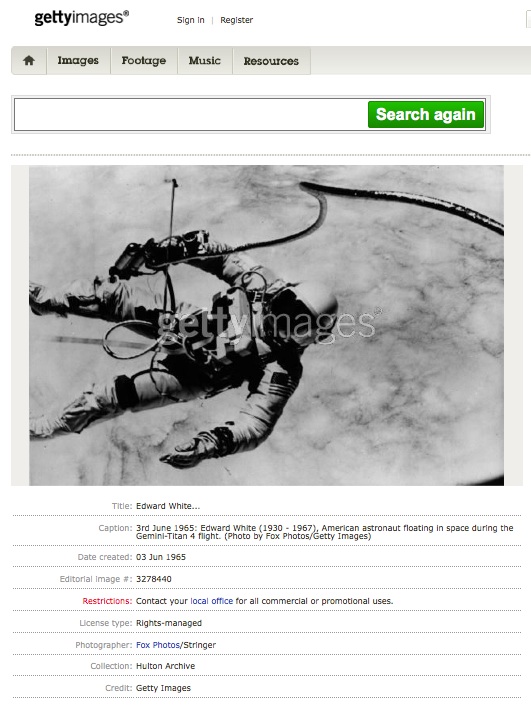Space For Sale
By:
October 7, 2010
Any quick-and-dirty Google search for astronaut imagery yields a visual feast, from photographs taken in space to clumsy astro-erotica. One image in a search I undertook this morning, however, caught my eye: a photograph of an astronaut floating above the Earth’s cloudscape, his reflective visor turned towards the camera, his foil-covered tether spiraling upwards to the craft. An unremarkable image from the space race, but for one detail — it was emblazoned with the watermark of Getty Images.
This made me wonder — after all, images gathered in the course of NASA missions belong to the American people; they’re born in the public domain, part of our cultural commons. On what basis does Getty claim the image?
Curious, I clicked through to the Getty web site.

Getty notes that the astronaut in the photograph is Edward White, and that the photo was made during the Gemini-Titan IV mission on the 3rd of June, 1965. As the screen shot above shows, Getty claims credit for the image and the right to manage the license. The entry also describes the photographer as “Fox Photos/stringer.”
Well, that “stringer” would have been James A. McDivitt, command pilot and the only other crewmember on the mission. Unless Fox managed to spirit a photographer into the capsule — now there’s a conspiracy theory!
I priced out Getty’s image for editorial use on the web: for a period of two years, they claim a price of $173.
The photograph is available — in a scan of the Kodachrome original — at nasaimages.org, a service provided by NASA in conjunction with Rick and Meghan Prelinger’s The Internet Archive.

Chatting with a Getty rights administrator about this image, I brought up the public-domain nature of NASA image licensing. “Ok, so you can feel free to use a image that as needed,” he replied. “However if that image is one that NASA has provided to Getty for licensing, or a image from the Getty site, then the license to it must first be purchased prior to usage.”
NASA’s own reproduction guidelines state that “you may use NASA imagery, video and audio material for educational or informational purposes, including photo collections, textbooks, public exhibits and Internet Web pages,” specifying only minimal restrictions for commercial use: “If the NASA material is to be used for commercial purposes, especially including advertisements, it must not explicitly or implicitly convey NASA’s endorsement of commercial goods or services.”
Getty’s entry for the image notes that it comes from the Hulton Archive, an image collection set up by Sir Edward Hulton, who published Picture Post, which was the LIFE of midcentury Britain. Surely, the image has its source in the image files of the Picture Post, to whom a negative would have been furnished by NASA public relations. The Hulton Archives include thousands of images, and it’s understandable that those with unique rights profiles might slip through the administrative cracks. But I wonder how many NASA images are claimed by Getty and other commercial image vendors, unintentionally or not. And I wonder how much money has been made from them.

